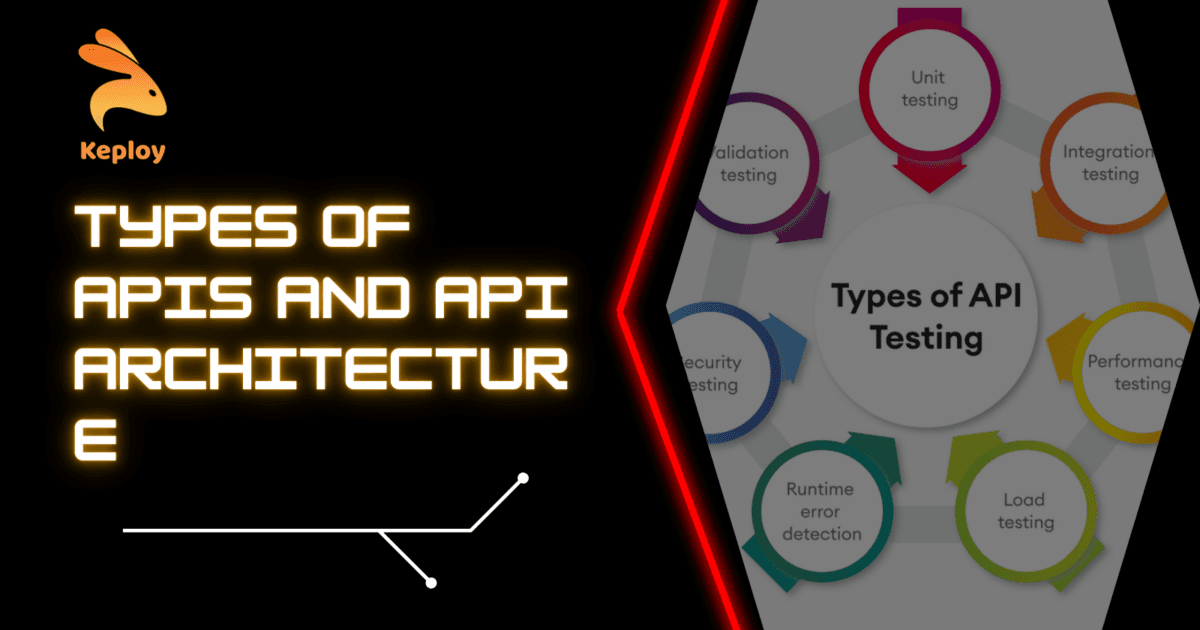A Comprehensive Guide to API Types and API Architecture Patterns
 KANISHAK CHAURASIA
KANISHAK CHAURASIATable of contents
- What is an API ?
- What is an API in general understanding?
- What are different types of APIs ?
- Types of APIs by purpose
- Types of API architectural styles
- Conclusion
- Frequently Asked Questions
- What is an API and why is it important?
- How does an API function in a software architecture?
- What are the different types of APIs based on access and security?
- What are the main purposes of different types of API?
- What are the common architectural styles for APIs?
- How do you choose the right API for a specific project?

What is an API ?
****Application programming interfaces, or APIs as they are more generally known, allow organizations to link systems, apps, devices, and datasets and to unlock data. It's important to understand which kind of APIs will be most effective for a project based on its intended use case, the people who will use and access these APIs, and the systems and datasets that must be linked. Determining the best kind of API to construct and designing the architecture accordingly are essential for efficient API performance and API maintenance. ****
What is an API in general understanding?
API acts as a link between the frontend and the backend. For example, if you went to the hotel and called the waiter to take your order, the waiter would go to the kitchen and tell the chef that this table number wants to eat these dishes. In technical terms, the frontend is your hotel, the waiter is an API, and the kitchen is the backend. What the waiter did was take the order, which means receiving the request from the client (user) and sending it to the kitchen (backend). thats the task of an API.

What are different types of APIs ?
The API defines endpoints and suitable query and response forms. Web APIs are the APIs used for communication between browsers. Services such as site notifications and Web storage are available. Different online APIs, including free, corporate, and partner APIs, offer varying levels of protection and privacy. A composite API, which is a collection of data or service APIs, can be integrated with other web APIs.
- Internal APIs: It is also known as private, internal APIs that are hidden from others and used within a company. This method enables firms to simplify information exchange across departments and locations. Internal APIs, while internally accessible, nonetheless provide security mechanisms to validate the employee's identification before providing system access, so they are less secure than other types of APIs.
External APIs: This API is also known as public or external, with open APIs providing relaxed security and allowing programmers and other users to freely access data. Some systems are completely transparent, while others may require a basic registry or API key. Because of this functionality, public APIs are an excellent alternative for businesses looking to expedite interactions with third-party users such as suppliers or customers. It also allows software developers to quickly and easily implement components.
Partner APIs: Partner APIs, like the open approach, seek to facilitate collaboration between a company and its external users. More encryption is used. however, to enable data access to certain business partners. While partner APIs are commonly available to other public APIs, third-party gateways restrict access to registered services.
Composite APIs: The composite API design can withstand several integration systems and all data. Because of this additional capabilities, Composite APIs are ideal for completing a single action with many services. It also gives developers access to numerous endpoints, such as web and other API applications, using a single function call. The strong composite API infrastructure improves data services and provides a system-integrated solution.
Types of APIs by purpose
It’s rare that an organization decides it needs an API out of the blue — most often, organizations start with an idea, application, innovation, or use case that requires connectivity to other systems or datasets.
System APIs: System APIs unlock data from core systems of record within an organization. Examples of critical systems that APIs could unlock data from include ERP, customer and billing systems, and proprietary databases.
Process APIs: Process APIs interact with and shape data within a single system or across systems — breaking down data silos. Process APIs provide a means of combining data and orchestrating multiple System APIs for a specific business purpose. Examples of this include creating a 360-degree view of the customer, order fulfillment, and shipment status.
Experience APIs: Experience APIs provide a business context for the data and processes that were unlocked and established with System and Process APIs. Experience APIs expose the data to be consumed by its intended audience — such as mobile applications, internal portals for customer data, etc.
Types of API architectural styles
Another area of choice for an API is which architectural style or styles will be employed. If certain functional capabilities are required, it is critical to select an architectural style or pattern that best supports the intended use of the API. This is often an API design decision made by more technically savvy teams.
There are various styles of architecture for APIs, as well as varying data formats within these styles, below we’ve listed some of the most common:
**REST API:** REST or (Representational State Transfer) is an architectural style that separates the concerns of the API consumer from the API provider by relying on commands that are built-into the underlying networking protocol. Clients use the included links and forms to perform actions (e.g. read, update, share, approve. etc.).
HTML is the best known example of this style and there are several other formats just for APIs (HAL, CollectionJSON, Siren, etc.). There are many benefits of REST APIs — including flexibility, and ability to accommodate popular data formats like JSON and XML among others.**RPC API:** Remote Procedure Calls — or RPCs — typically require developers to execute specific blocks of code on another system. RPC-style remote invocation of procedures other systems usually requires developers to call those procedures by name. RPC is protocol-agnostic, which means it has the potential to be supported on many protocols, but also loses the benefits of using native protocol capabilities (e.g. caching).
RPC architectural patterns can be observed in popular API technologies such as SOAP, GraphQL, and gRPC.
Event-driven API or Streaming API: Sometimes referred to as evented, real-time, streaming, asynchronous, or push architectures, event-driven APIs don’t wait for an API consumer to call them before delivering a response. Instead, a response is triggered by the occurrence of an event.
These services expose events to which clients can subscribe to receive updates when values on the service change. There are a handful of variations for this style including (among others) reactive, publish-and-subscribe, event notification, and CQRS.
Conclusion
In conclusion, APIs are essential tools for enabling communication and data exchange between different systems, applications, devices, and datasets. They act as intermediaries, similar to a waiter in a restaurant, facilitating requests and responses between the (client) and (server). Understanding the different types of APIs and their specific use cases can help organizations choose the most effective API for their projects.
Additionally, recognizing the purpose of APIs—whether system, process, or experience APIs—and selecting the appropriate architectural style, such as REST, RPC, or event-driven, are crucial steps for ensuring efficient API performance and maintenance. By carefully considering these aspects, organizations can design robust APIs that enhance connectivity, streamline operations, and foster innovation.
Frequently Asked Questions
What is an API and why is it important?
An API (Application Programming Interface) is a set of protocols and tools that allows different software applications to communicate with each other. APIs are crucial because they enable the integration of various systems, apps, devices, and datasets, facilitating data exchange and enhancing functionality across platforms.
How does an API function in a software architecture?
In software architecture, an API acts as a mediator between the frontend (user interface) and the backend (server). For example, when a user places an order in a web application (frontend), the API sends this request to the server (backend), processes it, and then returns the response to the user interface.
What are the different types of APIs based on access and security?
- Internal APIs: Used within a company and not exposed to external users, enhancing internal communication and data exchange.
External APIs: Open to developers and external users, often with relaxed security measures, promoting third-party integrations.
Partner APIs: Shared with specific business partners, featuring enhanced security to protect sensitive data.
- Composite APIs: Combine multiple data or service APIs, allowing for complex operations through a single API call.
What are the main purposes of different types of API?
System APIs: Unlock data from core systems such as ERP and customer databases.
Process APIs: Interact with and combine data from multiple systems to fulfill specific business needs.
Experience APIs: Provide data and processes in a format suitable for end-user consumption, such as mobile applications or internal portals.
What are the common architectural styles for APIs?
REST API: A flexible style that separates the concerns of API consumers and providers, supporting formats like JSON and XML.
RPC API: Requires calling specific procedures on a remote server, which can result in tight coupling between API consumers and providers.
Event-driven API : Delivers responses triggered by events rather than requests, suitable for real-time updates and asynchronous communication.
How do you choose the right API for a specific project?
To choose the right API, consider the project's use case, the intended users, and the systems and datasets that need to be integrated. Determine the API type (internal, external, partner, or composite) and purpose (system, process, or experience). Select an appropriate architectural style (REST, RPC, or event-driven) to ensure the API meets the functional and performance requirements of your project.
Subscribe to my newsletter
Read articles from KANISHAK CHAURASIA directly inside your inbox. Subscribe to the newsletter, and don't miss out.
Written by

KANISHAK CHAURASIA
KANISHAK CHAURASIA
I'm community builder and a frontend developer. Experienced in Nextjs and tailwind css. keen interest in web3 and blockchain